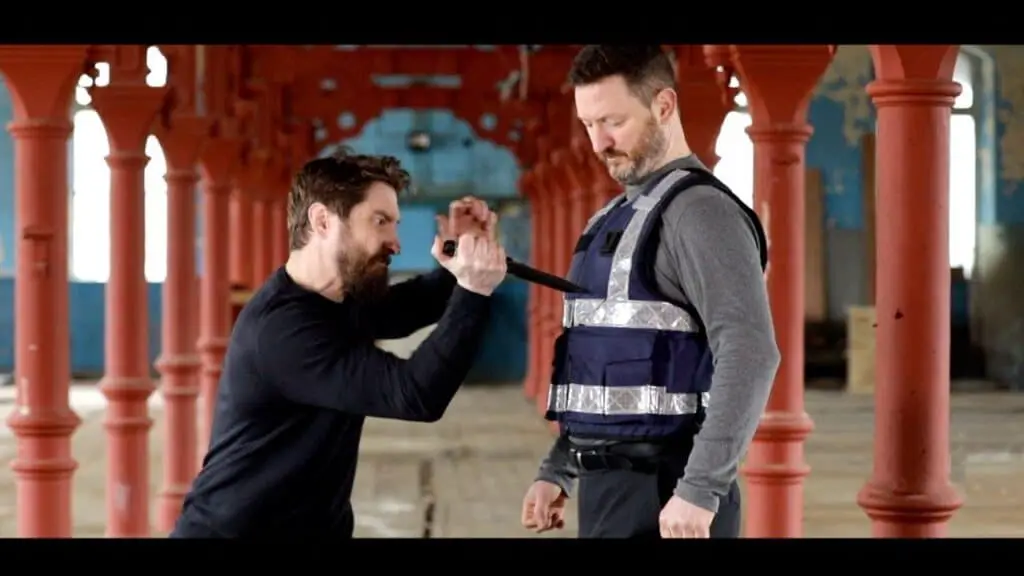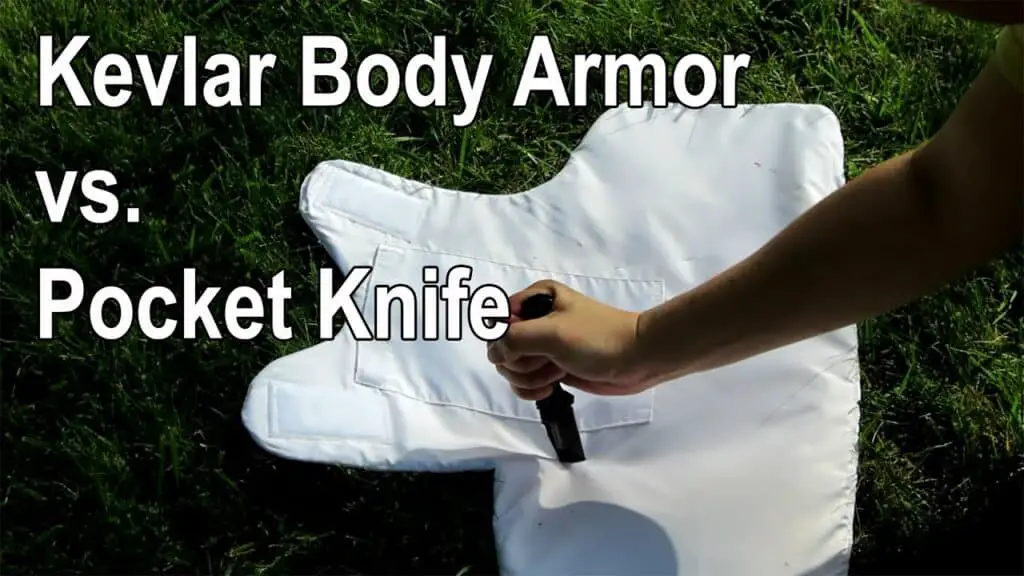If you’re in a dangerous line of work or if you’re just plain curious, you may be wondering if a Kevlar vest can stop a knife. If you use Kevlar vests for protection, you’ll want to know if they are reliable at preventing stab wounds.
No, Kevlar vest is one hundred percent impenetrable; they are knife-resistant rather than knife-proof. Several factors, such as the age and condition of the vest, affect how reliably a Kevlar vest can resist a knife. Also, it is important to choose the correct protection level for your needs.
Of course, you are more protected from being stabbed by a sharp object when wearing a Kevlar vest as compared to not, but you are not invincible. Read on to find out what exactly Kevlar is and how it works to protect you from a knife attack.

Can You Be Injured by a Knife While Wearing a Kevlar Vest?
So, you know that a Kevlar vest isn’t 100% stab-proof but that it also can slow down the rate at which a knife can pierce through the material. That certainly shouldn’t make you give up the idea of wearing a Kevlar vest altogether as it does provide a lot of protection. It’s just not indestructible.
The next logical question is if you can get injured by a knife while wearing a Kevlar vest. And if so, how severe of an injury could you sustain while wearing a knife-resistant vest?
The Type of Blade Affects How Well a Knife Can Penetrate Kevlar
If you’re wearing a Kevlar vest marketed for edged blade protection, you will still be vulnerable to thin, sharp instruments. Ice picks, screwdrivers, and needles can be narrow enough to slip through the holes in the weave of the Kevlar vest. If a perpetrator is using a weapon with a thin, sharp point, you will be more susceptible to injury.
The Angle of a Blade Plays a Role in Piercing Kevlar
Professional testing of knives on Kevlar vests does not take into account various angles from which a person could be stabbed:
“National Institute of Justice (NIJ) sets the spike or stab maximum penetration depth at 7mm (0.28″) from a thrust at a 90 degree angle (perpendicular) to the protective material.”
National Institute of Justice | Body Armor Guide
Kevlar is designed to slow down the force of a stab from a 90-degree angle but doesn’t account as well for other angles.
Injuries While Wearing Kevlar Depend on the Force of the Knife Impact
The strength and intent of an attacker can vary widely so you can still sustain injuries while wearing a Kevlar vest. If a large, powerful assailant is stabbing you with all of their force with an intent to kill, you can be seriously injured. The Kevlar slows down the blade to dull the injury but not completely prevent it.
In short, you can still be injured by a knife while wearing a Kevlar vest. The severity of the injury depends on the various factors listed above and can range from minimal bruising to death. However, wearing a Kevlar vest provides you the most protection possible.
How Can You Maximize the Effectiveness of Your Kevlar Vest?
Without proper care, your Kevlar vest will not be as effective or long-lasting. To improve the effectiveness and longevity you get from your vest, you need to know how to care for it.
Ensure a Proper Fit for Your Kevlar Vest
First of all, make sure that your Kevlar vest fits properly. A vest that is too tight could stretch out the fibers and weaken them over time, lowering the density and reducing the protection from stabbing attacks.
Store Your Kevlar Vest Properly
To maintain your Kevlar vest as long as possible, it’s important to store it properly. The vest should be laid flat rather than hung up on a hanger. Using a hanger can stretch out the straps over time. It’s also essential that the vest never be balled up in a laundry basket as that can cause it to become misshapen and will affect the integrity of the vest.
When Should You Replace Your Kevlar Vest?
If your Kevlar vest has been penetrated by a knife, you should certainly look into replacing it right away. A Kevlar vest that has been damaged by a sharp object will not offer the same protection as a vest with no damage. While a knife can cut the fabric of the Kevlar vest, it will typically not go all the way through. However, the fibers will no longer be tightly woven in the area where the damage occurred.
Even if you’re not aware of an incident where damage may have occurred to your Kevlar vest, it’s still a good idea to inspect it before each use. The more a Kevlar vest gets worn, the more wear and tear can occur. This will affect the level of protection, so you may need to replace it.
How Does Kevlar Stop Knives?
If you were wearing a Kevlar vest and someone tried to attack you with a knife, the strong, tightly woven fibers of the vest would interfere with the knife’s point of impact. The Kevlar fibers cause the knife to get tangled up in the material rather than going straight through. Essentially, this slows down the impact of the sharp object and it will be less effective at piercing the target (you).
Testing of Kevlar vests done by Mecmesin in 2019 showed that the tightly woven fibers moved around the point of the knife during impact, preventing a full-puncture condition from occurring.

What Types of Protection are Offered by Kevlar Vests?
There are three types of protection offered by Kevlar vests geared toward protection from specific types of weapons.
Ballistic Protection
This type of Kevlar vest is made for protection from bullets and is commonly known as a bulletproof vest. The level of the vest determines which specific types of bullets it is made to withstand.
Edged Blade Protection
Kevlar vests made for edged blade protection are often called stab-proof vests. Many of these vests will also include ballistic protection making them more effective for resistance against a variety of weapons, including knives, axes, broken glass, and bullets.
Spike Protection
While you may think spike protection would be the same as edged blade protection, this type of Kevlar vest does need to be made differently. Weapons such as needles and screwdrivers that can be narrower than bullets and knives can possibly get through the chainmail and Kevlar in the other two types of vests. Spike protection vests often combine the protections of the bulletproof and stab-proof vests, then add an additional plastic laminate layer.
What Levels of Knife Protection are Available for Kevlar Vests?
Since we are focusing on the ability of a Kevlar vest to stop a knife, we’ll take a look at the protection levels for the edged blade vest. Below is a table showing the data for knife resistant level 1 and 2 vests as determined by the National Institute of Justice.
| Knife Resistant Level 1 | Knife Resistant Level 2 | |
| Energy Level | E1 | E1 |
| Energy (joules) | 24 | 33 |
| Velocity | 5 m/sec | 5.9 m/sec |
| Total Missile Mass | 1.9 Kg | 1.9 Kg |
| Maximum Penetration | 7 mm | 7 mm |
Kevlar Vests: Highly Protective but Not Impenetrable
Kevlar vests can protect you when being stabbed by a sharp object, but they aren’t one hundred percent impenetrable. Choosing the right protection level, keeping up with proper care, and replacing your vest as needed will afford you the maximum benefits that Kevlar can provide.
OUR RECOMMENDED TACTICAL GEAR LIST:
- Best Health and Fitness Tracker, Whoop. Get 1 Month Free: See it here!
- EDC Assisted Opening knife we can’t live without: See it here!
- Best EDC Concealed Carry Pistol: See it here!
- Extreme Performance Morning Dink: See it here!
- Best 3D Printer For Gun Parts and Accessories: See it here!
- Our Top Rated EDC Flashlight: See it here!
- AR Red Dot Sight We Can’t Live Without: See it here!
- Best Handgun Safe For Quick Access: See it here!
- Top Wireless Security Camera For Home Security: See it here!
- The Range Bag You’ve Always Been Looking For: See it here!
- CIA Approved Sharp Shooting Course: See it here!

